 |
||
|
||
| ||



Here we should start speaking about SuperMicro Systems Corp., or simply SUMA. For a long time we called it SUMA, though it's not true. This company was founded in Seoul, the capital of South Korea, in 1998, that is why this is a relatively young firm. However, for 4 years the company achieved a great success. First of all, in the homeland. In 2001 SUMA took the first place among all firms in Korea in the pace of development. In the beginning the company produced stuff by request of OEMs, and primarily for Samsung. Among first products of SUMA were 3dfx Banshee based cards. But this was the first and the last attempt of the company of working with products of non-NVIDIA processor makers. Later all SUMA's video cards were based on the NVIDIA's chips. In 2000 the company entered the Retail market with its Platinum series. Today video cards from SUMA are very popular and have a great deal of fans. Before we go further into examining the today's samples let's see what reviews of the GeForce4 Ti cards we already have. Theoretical materials and reviews of video cards which concern functional properties of the NVIDIA GeForce4 Ti GPU
SUMA produces almost the whole range of cards on the NVIDIA's GPUs. That is why when the GeForce4 Ti just appeared on the market this Korean company was among those who expressed a desire to make a card on it. Today we will examine two cards - SUMA Platinum GeForce4 Ti 4400 DVI and Platinum GeForce4 Ti 4600 SE. CardsBoth cards have an AGP x2/x4 interface, 128 MBytes DDR SDRAM located in 8 chips on both sides of the PCB.
There are some slight differences from the reference design in the right parts. It seems that SUMA redesigned a unit which controls power supply to the components. Note that we noticed no any deviations in stability. The PCB is traditionally black. Silvery (or maybe platinum :-) letters of the name are on the right. The suffixes DVI and SE are made in the form of stickers. As far as "DVI" is concerned the idea is clear: before the Ti 4400 card was released there was a card without DVI (and of course, without a dual-head support, from the nView's standpoint). The SE of the Ti 4600 card implies that it supports VIVO. The card without SE comes with a simple TV-out. The cooling device is similar to what you could
see in the ASUSTeK
review. The cooler is unusual: its fan looks like a turbine.
Besides, the heatsink is very big. That is why the cooler is quite
heavy, though it is made of aluminum. The SUMA's logo with an eagle is located in
the center of the heatsink. Such design makes the cards very stylish. Besides, the memory chips are covered with elegant heatsinks (which are not paired). Everything I said before concerns both cards. The
cards differ just in the memory chips and of course GPU (Ti 4400
is above, Ti 4600 is below): 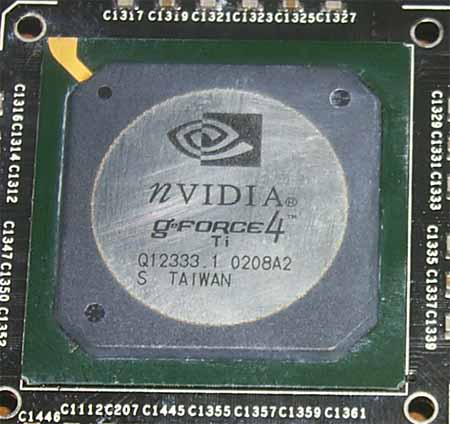 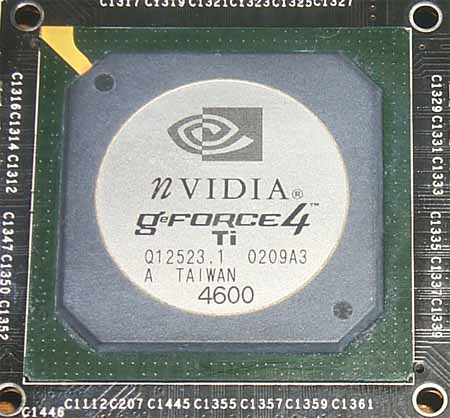 The SUMA Platinum GeForce4 Ti 4600 SE comes with the GeForce4 Ti 4600 chip produced at the beginning of March, it doesn't have a codename. Besides, you must have noticed a new stepping A3 (revision). The Platinum GeForce4 Ti 4400 DVI card has a processor produced at the end of February, also just with the marking (but without figures 4400). The chip is of the A2 revision. Furthermore, the Ti 4400 has DVI and d-Sub connectors unsoldered, while the Ti 4600 has two DVIs. Two CRT monitors can be connected with DVI-to-VGA adapters (which are supplied with the cards). The Ti 4400 model is equipped with the TV-out, which works via the Conexant codec and the Ti 4600 SE model has a Philips 7108 processor. This DAC/ADC controls VIVO (Video-In Video-Out). Quality of operation of the TV-out and VIVO in such cards was already estimated (see the list above). However, I couldn't find the software for VIVO among the accessories of the Ti 4600 based card (as you know, it is not FreeWare). Now let's jump into the packages.
Both cards ship in the retail packages. Overclocking
The overclocking results are moderate (especially of the Ti 4600). Note:
 Test system and driversIn the tests we estimated how the performance of the accelerator depended on the CPU's frequency (and on a platform), that is why we used several testbeds:
The test system was coupled with ViewSonic P810 (21") and ViewSonic P817 (21") monitors. In the tests we used NVIDIA's drivers of v28.90. VSync was off, S3TC was off. For the comparative analyses we used the following cards:
Test resultsThe 2D quality is superb, no problems even at 1600x1200x85 Hz. For estimation of 3D quality we used:
The tests were carried out in the 32-bit color mode. For each test I made two diagrams which group the results differently (for processors and for video cards/AA modes). 3D Mark2001 SEGame1 Low Details
1024x768
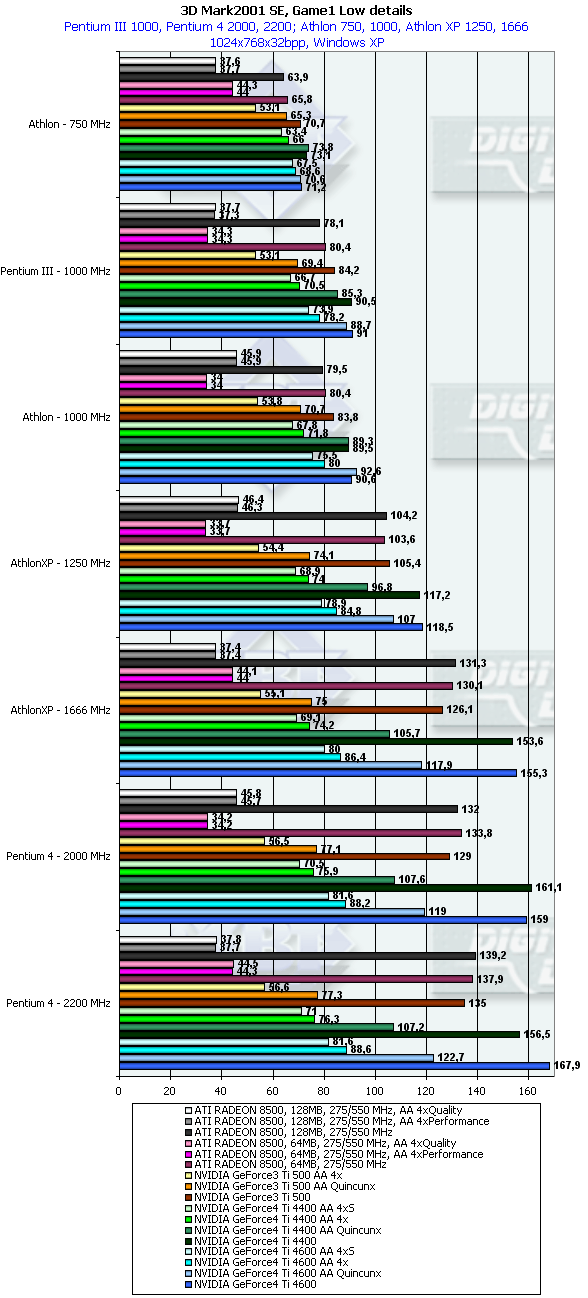
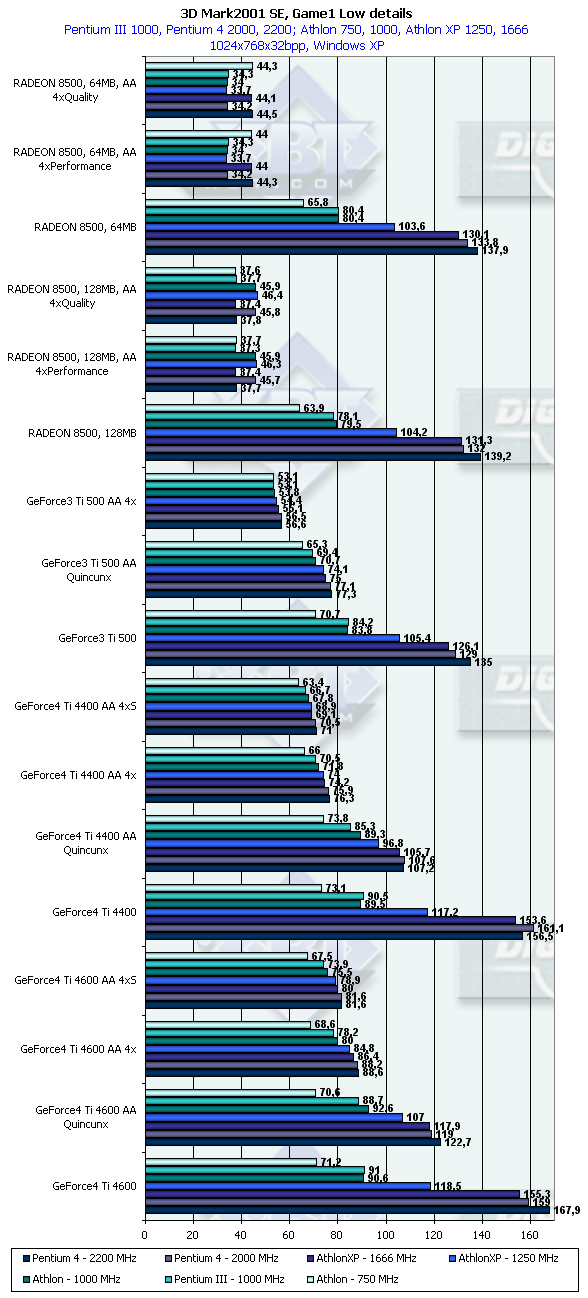 Note that we do not compare AA quality of the GeForce4 Ti and GeForce3 Ti 500 as it was done in the ABIT Siluro GF4 Ti review. I have chosen the 4x mode of the SmoothVision (ATI)
(Performance and Quality) as it is the closest in quality to the
4x and 4xS of NVIDIA and it demonstrates acceptable speed and performance
in 1024x768. As you can see, the ATI 4xP mode gives better quality
than the NVIDIA's Quincunx. We can compare them only in quality,
not in speed. The performance drop of the RADEON 8500 is great,
on all processors and platforms. 1280x1024
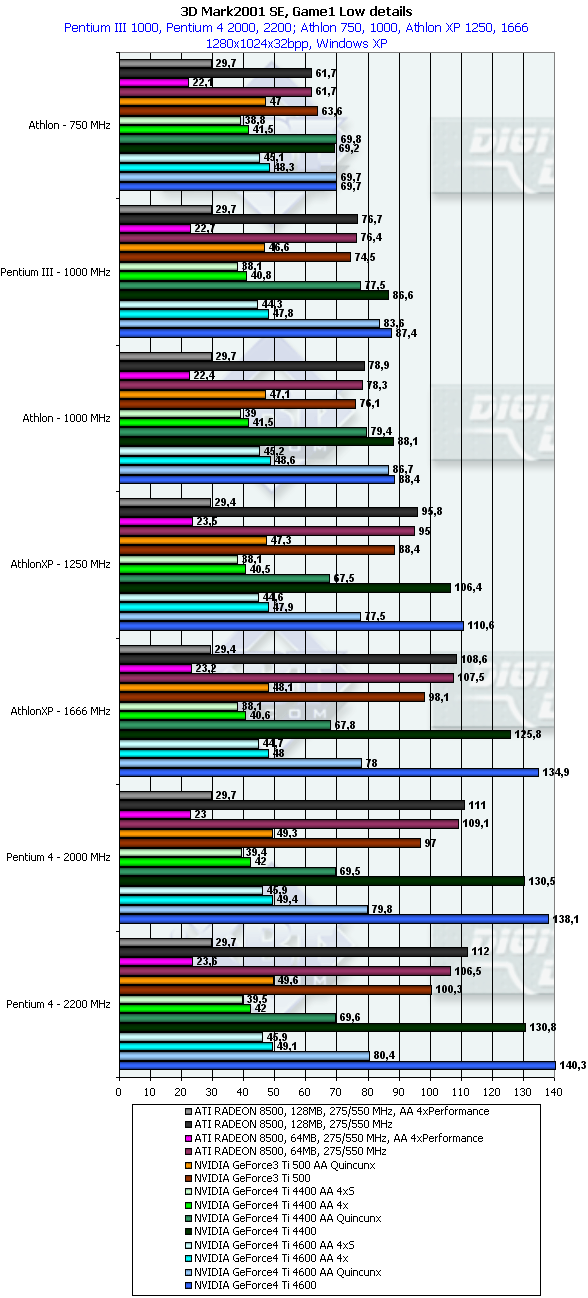
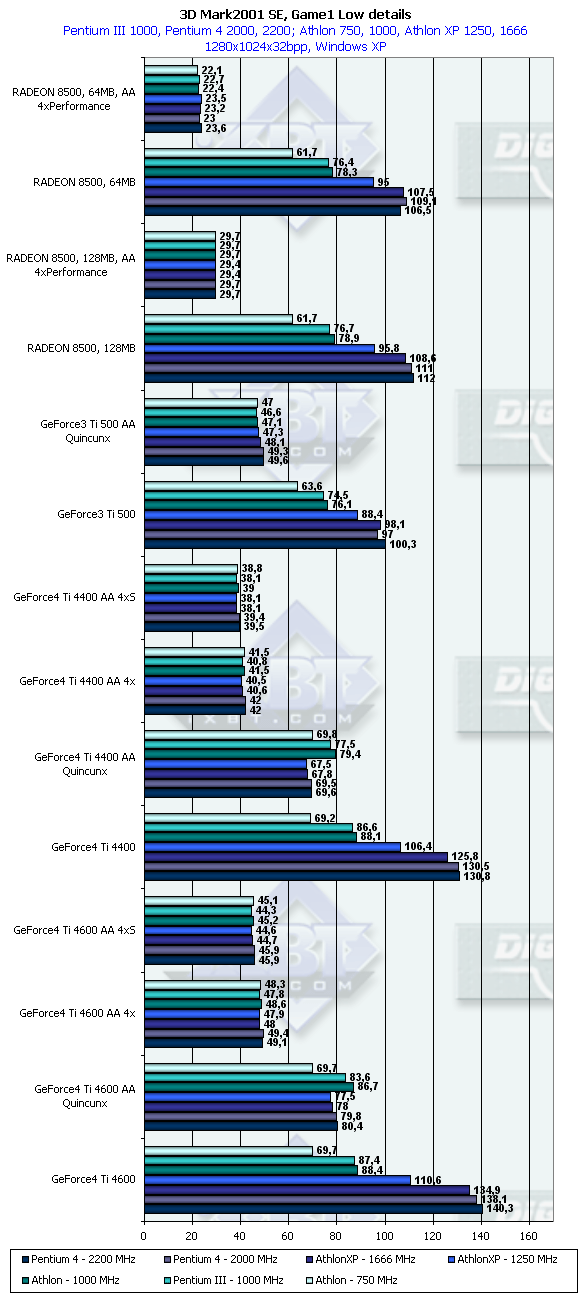 This resolution makes stronger the victory of the NVIDIA cards in the AA modes. In case of the anisotropic filtering the RADEON 8500 was a leader, and here it is vice versa. Note that AA is one more component which improves image quality. Game2 Low Details
1024x768
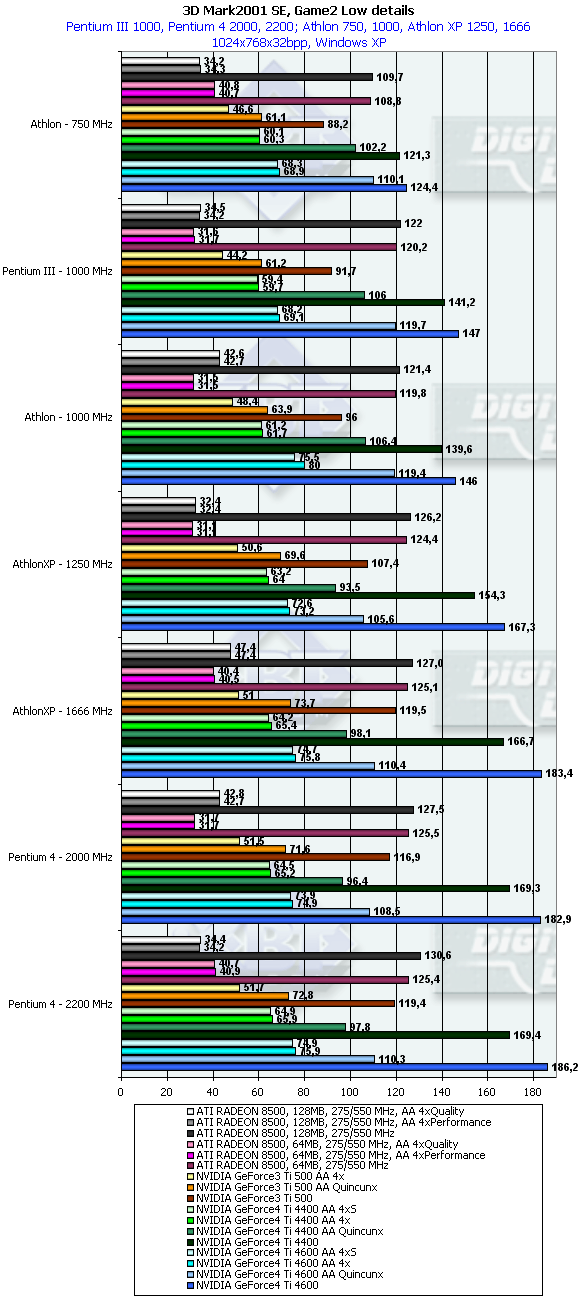
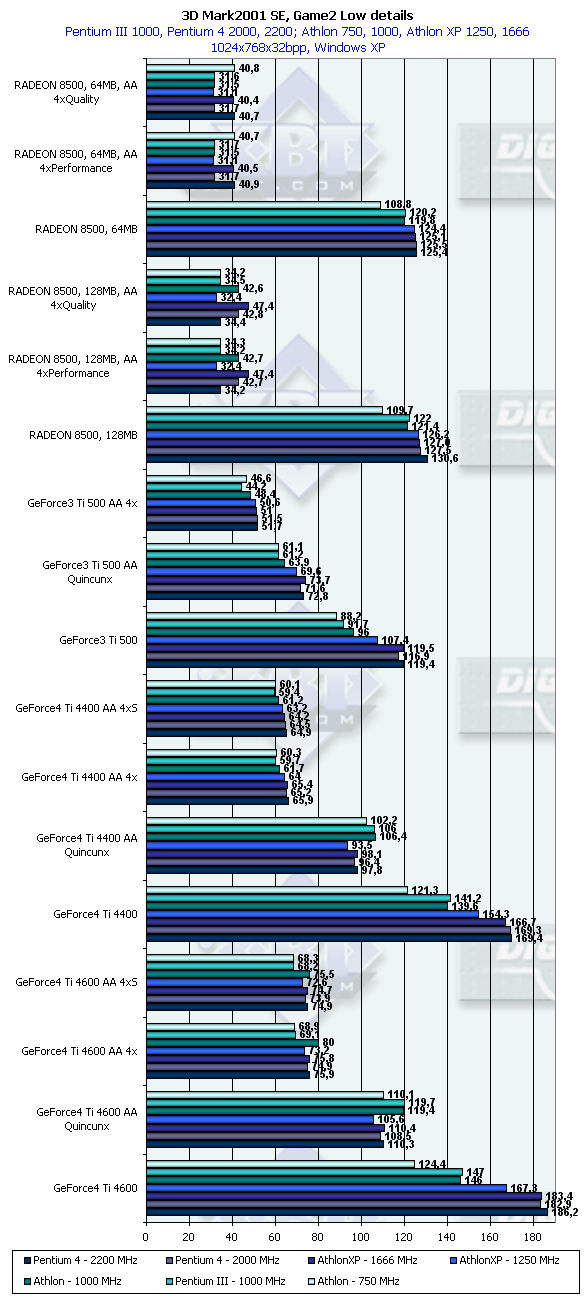 The RADEON 8500 128 MBytes works strangely: sometimes its performance is much better than that of the 64 MHz model, sometimes it is worse. We retested it but got the same. In all other respects the situation is similar
to the Game1. Just note that quality of the AA 4xP of ATI is a little
better than that of the NVIDIA's AA Quincunx. 1280x1024
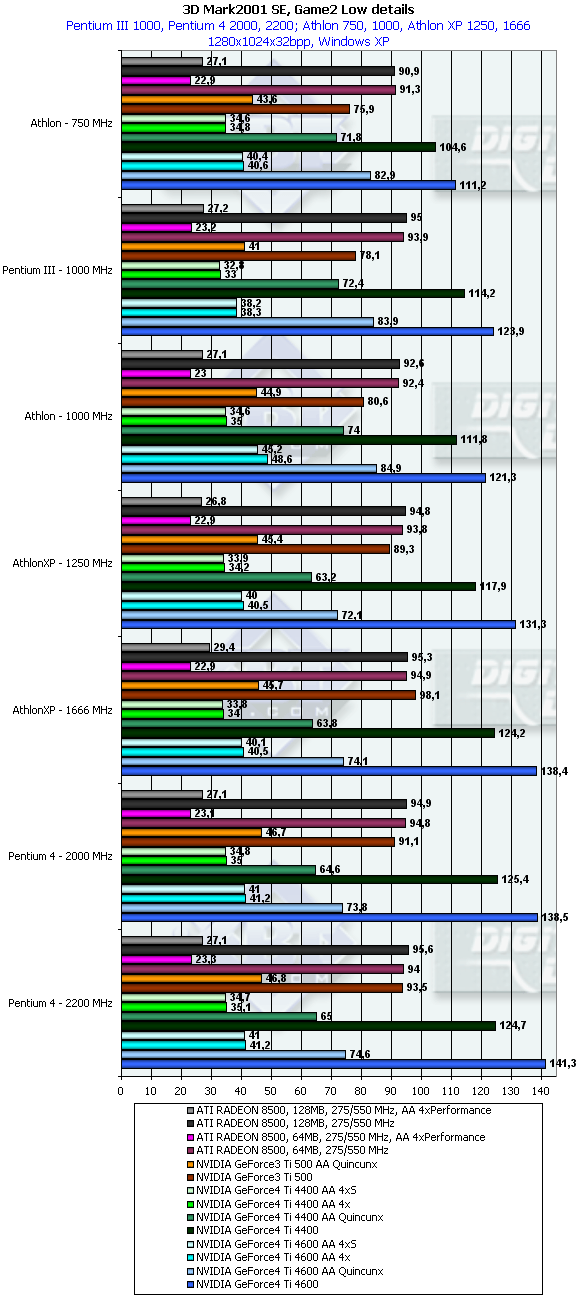
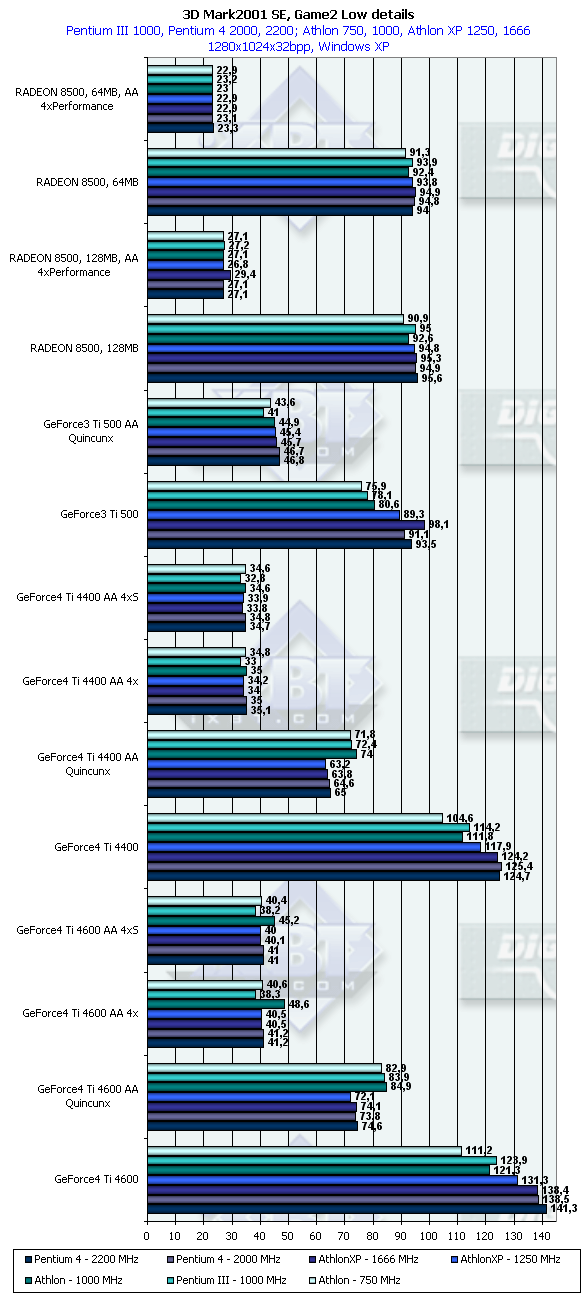 The situation is similar, it is just a tad worse for the RADEON 8500. Note that the 128 MBytes memory of the NVIDIA's cards allows them to activate AA 4x in 1280x1024, though the same amount of memory on the RADEON 8500 based card doesn't help it enable the AA 4xQ. Next time, in the review of the silvery Triplex GF4 Ti 4600 card we will analyze Game3 and Game4 tests. ConclusionWhen the AA is enabled, the GeForce4 Ti based cards are real winners. Next time we will estimate operation of these cards with the AA and anisotropy enabled simultaneously. The S/U/M/A cards are based on a little altered reference design; quality of soldering and quality of all the components is excellent. The GeForce4 Ti 4600 based card comes with VIVO (though the software is lacking); besides, both cards have heatsinks on their memory modules. Finally, they have a traditional stylish package which is pleasant to look at. Having analyzed the price changes on the market, we can see that prices of such cards have recently dropped considerably; and it makes them closer to consumers. The complete characteristics of video cards of this and other classes can be found in our 3Digest . Highs:
Lows:
 Write a comment below. No registration needed!
|
Platform · Video · Multimedia · Mobile · Other || About us & Privacy policy · Twitter · Facebook Copyright © Byrds Research & Publishing, Ltd., 1997–2011. All rights reserved. | |||||||||||||||||||||||||||||||||||||||||||||||||||||||||||||||||||||||||||||||||||||||||||||||||||||||||||||||||||||||||||||||||||